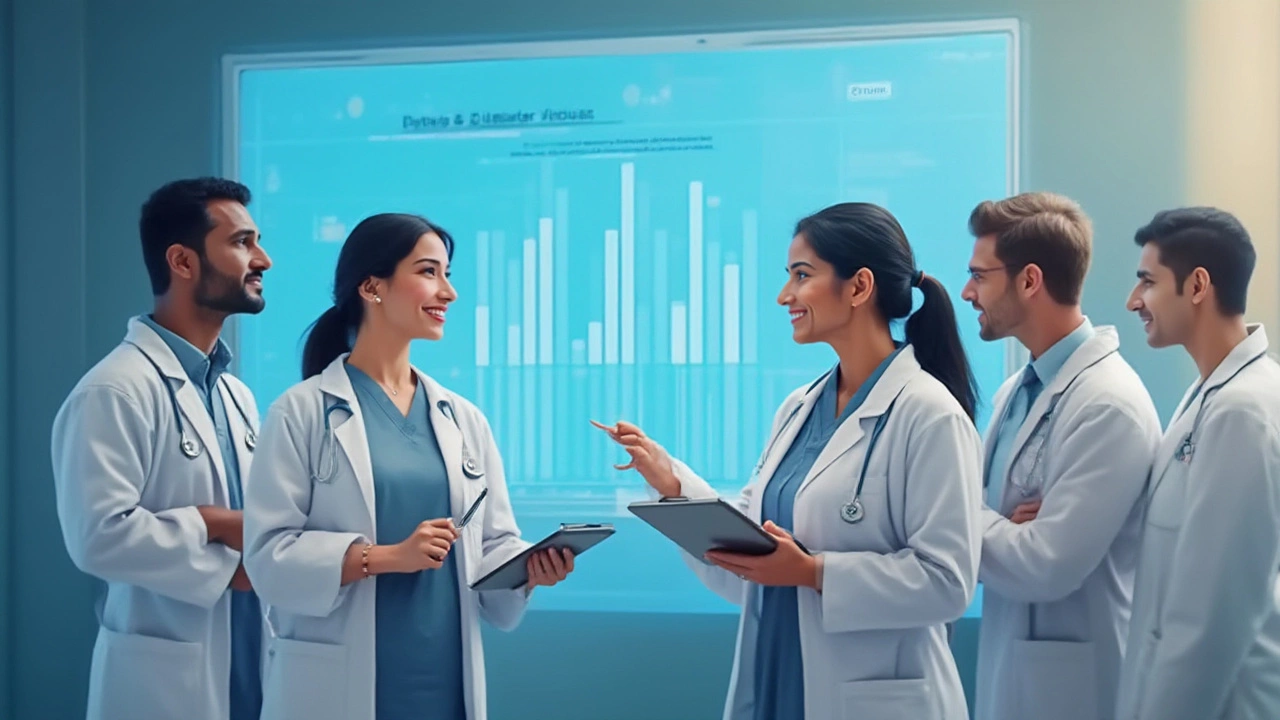
Did you know a person gets diagnosed with type 2 diabetes every ten seconds? It’s not just scary—it’s confusing, too, because figuring out which pill or injection to trust feels like gambling with your health. Picking the best diabetes medication is a real-life balancing act. You want to bring your blood sugar down, but goodness, who wants side effects like bad stomach cramps, sweating, or endless runs to the washroom? The truth: Not all diabetes drugs are the same, and some are much friendlier to your body than others.
The Main Types of Diabetes Medications: What Are Your Options?
Let’s untangle the mess of options your doctor might mention, starting with the essentials. The most common drugs for type 2 diabetes fall into four main families: metformin, sulfonylureas, DPP-4 inhibitors, SGLT2 inhibitors, and GLP-1 receptor agonists. Metformin has been around since the 1950s—it’s trusted, it’s in every guideline, and it’s cheap. Fun fact: about 80% of newly diagnosed patients try metformin first. Sulfonylureas, like glimepiride and glyburide, push your pancreas to release more insulin, but they come with a real risk of low blood sugar and sometimes weight gain.
DPP-4 inhibitors, with names like sitagliptin (Januvia), work by blocking a certain enzyme so there’s more insulin after you eat. These are popular because their side effects are pretty mild. Next up, SGLT2 inhibitors—drugs like empagliflozin (Jardiance) and canagliflozin (Invokana)—which make you pee out the extra sugar. Their superpower is helping with weight loss and even lowering heart disease risk, but they can cause yeast infections or make you run to the toilet often. There’s also a new star: GLP-1 receptor agonists (like semaglutide and liraglutide) which started as diabetes meds but got famous for helping people lose weight, sometimes up to 12% of their body weight. These drugs mimic a natural gut hormone, telling your brain you’re full sooner and slowing your stomach, but nausea can creep up for some users.
Here’s the thing—there’s no one-size-fits-all answer, and your doctor will consider whether you have heart or kidney problems, your insurance, and your preferences. The US and Europe both rate metformin and SGLT2 inhibitors highly, especially for those with heart risks. And recently, a Lancet study showed people do better on a combo of metformin plus a GLP-1 receptor agonist, with fewer dangerous side effects than old-school combos. Doctors now tweak your treatment path around your lifestyle, heart health, and, honestly, your wallet.
The Medication With the Fewest Side Effects: Is Metformin Still King?
Ever heard someone say, “Metformin is a miracle drug”? It’s mostly true for mild-to-moderate type 2 diabetes. Most people handle metformin just fine. About 15% might get belly trouble—think gas, mild diarrhea, or cramps—especially when starting or when doctors ramp up the dose too quick. But get this: The stomach issues usually fade in a few weeks, and taking it with food helps a lot. Unlike many drugs, metformin rarely causes low blood sugar (hypoglycemia) or weight gain. As of 2025, it’s been through more safety studies than any diabetes drug on Earth.
Now, if you’re one of the unlucky few who simply can’t tolerate metformin (or it’s not enough), doctors look to the newer classes. DPP-4 inhibitors are gentle on the body—less than 3% get rashes, cough, or mild joint pain. SGLT2 inhibitors, while trending, have a slightly higher chance of urinary or yeast infections. A tip: Drink plenty of water and don’t skip bathroom breaks when taking these. GLP-1 receptor agonists are about as close to a weight-loss shot and diabetes treatment together as we’ve found, but they’re not side effect free. Up to half of people feel nausea the first month, but this fades for most folks. Fewer than 2% stop using them due to side effects, though, so if you’re patient, the perks can outweigh the drawbacks.
Compare serious risks? Old school sulfonylureas and insulin are more likely to cause low blood sugar crises, especially if meals aren’t predictable. Rarely, metformin may cause vitamin B12 deficiency if taken for over five years—but a yearly check can nip this in the bud. Here’s a handy table to make the comparison easy:
| Drug Class | Main Upside | Common Side Effects | Notable Risks |
|---|---|---|---|
| Metformin | Safe, effective, weight-neutral | Stomach upset (10-15%) | Rare: B12 deficiency (long-term) |
| DPP-4 Inhibitors | Gentle, no weight gain | Runny nose, joint pain | Very rare: pancreatitis |
| SGLT2 Inhibitors | Weight loss, heart protection | UTIs, increased urination | Rare: Ketoacidosis, dehydration |
| GLP-1 Agonists | High weight loss, heart benefits | Nausea, vomiting | Very rare: pancreatitis, gallstones |
| Sulfonylureas | Lower cost, rapid effect | Hypoglycemia, weight gain | Risk of severe low sugars |

Factors That Matter: Body, Lifestyle, and Beyond
So, how do you and your doctor pick? It goes way beyond just “Which pill is safest?” Let’s get real: If you love carbs, struggle with snacking, or have a family dinner tradition every night, a drug with a risk of low blood sugar might not cut it. If you have kidney disease or heart trouble (which, shockingly, around 40% of type 2 patients do), SGLT2 inhibitors or GLP-1 receptor agonists get big gold stars. For those on a budget or in countries where newer medications aren’t covered, metformin and sulfonylureas might make more sense, but always put safety center-stage.
There’s another twist: Your DNA, age, weight, and even gut bacteria affect how you respond to each drug. A Johns Hopkins study from 2023 showed that people with a gene called SLC22A1 needed a much lower dose of metformin to get the same sugar-lowering punch. Hormones play a part, too—women tend to get more side effects from GLP-1 shots. If you’re over 65, certain drugs might work better but carry more risks. That’s why personalized medicine is booming right now. Some hospitals even test patients for genetic markers before writing a script.
Pro tip: No matter your age or health status, log your symptoms, sugars, and side effects for the first two months on a new med. Apps like MySugr and Glucose Buddy make it way easier to spot patterns. If you’re planning a pregnancy or breastfeeding, always double-check with your doctor, since not all diabetes meds are safe for babies. If weight loss is a top goal, ask about GLP-1 agonists—they’re pricey, but many insurance plans now cover them, especially if you have other health conditions.
Tried-and-True Tips To Minimize Diabetes Medication Side Effects
No one likes popping pills and crossing their fingers. Here’s what works to dodge the worst side effects. First up, timing is everything. Take metformin with your meal, not on an empty stomach, to duck that queasy feeling. If you’re starting on a GLP-1 agonist, start low and ramp up slowly; the rush to the top dose is where nausea hits hardest.
- Hydrate like it’s your job. SGLT2 inhibitors flush sugar out, but if you’re not drinking enough, getting dizzy is almost guaranteed.
- Eat smaller, frequent meals for the first couple of weeks on a new med—this helps curb tummy troubles and keeps your blood sugar steady.
- If you get diarrhea or cramps from metformin, ask for the extended release version—less than 5% of people have trouble with this form versus about 15% with the old one.
- Wear loose, breathable clothes if you’re prone to yeast or bladder infections on SGLT2 inhibitors, and practice extra hygiene after workouts or sweating.
- If you’re worried about vitamin B12 deficiency from long-term metformin, a simple blood test once a year and a daily multivitamin can fix it before it causes fatigue or nerve tingling.
Always keep in mind that the “best” medicine isn’t always the most expensive or new—it’s the one you can stick with, that fits your life, and keeps your sugars right where they belong. If something feels off, don’t wait for your next checkup. Call your doctor or pharmacist; sometimes the fix is as easy as switching to a different version or adjusting a dose.

Looking Into The Future: What’s Next for Safe Diabetes Medications?
The diabetes world moves fast. Just last year, the FDA approved new combo pills blending SGLT2 inhibitors with DPP-4 inhibitors, aiming to hit more sugar targets without new side effects. Researchers in 2025 are excited about “smart insulins” that kick in only when your sugar spikes—cutting the risk of lows in half. Even cooler? Oral versions of GLP-1 agonists (like pills instead of weekly needles) are now reaching the market, and early data says they’re just as effective with way milder nausea in most people.
AI is quietly changing your doctor’s office, too. Some clinics use AI-powered dashboards that scan your glucose data, pinpoint side effects, and recommend drug changes in real time. A pilot in Mumbai saw a 30% drop in hospital visits by patients using these dashboards. Meanwhile, digital twin technology—where you have a virtual “you” showing how you might react to a drug—means fewer surprises and more tailored care.
Scientists are also trying to create microbiome-friendly medications that “talk” to your gut bacteria, aiming to beat diabetes without a single pill. Beta cell regeneration drugs, which could wake up insulin-producing cells, are in the works for mild to moderate diabetes, but human trials won’t finish until 2027. Don’t be shocked if, five years from now, we’re talking about type 2 diabetes in the past tense for half of today’s patients. Until then, stay curious, track your symptoms, and make your doctor your ally rather than your last resort. Choosing the best diabetes medication takes patience—but with the right facts and a little self-advocacy, you can dodge the worst side effects and feel more like yourself every single day.

Write a comment